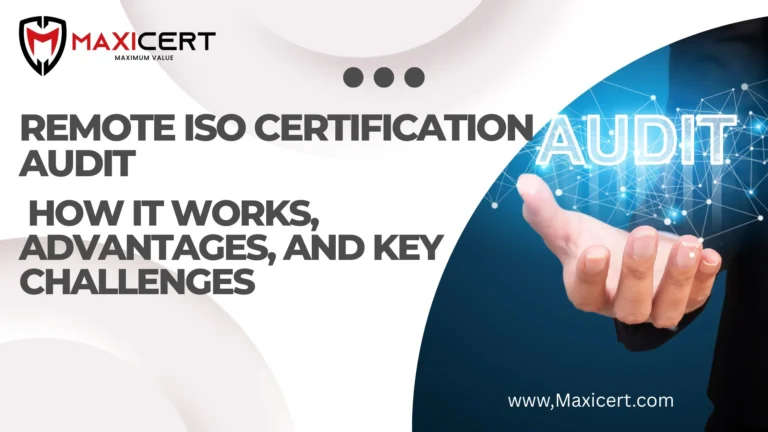Remote ISO Certification Audit: How It Works, Advantages, and Key Challenges

Introduction
Gaining ISO certifications opens doors for credibility and international recognition of your business activities. Unfortunately, in the past, obtaining such certification would require a team of auditors to visit a business site in order to inspect compliance processes and carry out monitoring activities. With the onset of digital transformation, businesses began to adopt a far better, faster alternative: remote ISO certification audits.
Such audits help organizations achieve,,d to a certain extent, maintain ISO compliance, which would otherwise require auditors to conduct physical visits. These audits are very convenient for global businesses, companies that have multiple branches, and for sectors that have very limited time.
Maxicert, therefore, is well-positioned to help businesses around the globe in obtaining these certifications.
By understanding the process, you’ll see how remote ISO audits can improve operational efficiency, global accessibility, and employee engagement. Finally, we’ll explain why partnering with Maxicert ensures a seamless, secure, and globally recognized certification experience for your organization.
Request A Free Quote
What is a Remote ISO Certification Audit?
A remote ISO certification audit is a digital assessment that involves checking an organization against the ISO standard. The audit is done using a form of virtual technology, for instance, reviewing documents with the help of video conferencing and different digital tools.
On-site audits → The auditor moves and inspects the premises, interviews staff, and examines the equipment stored in the facility.
Remote audits → The auditor examines and runs scans and evaluations on processes using screen shares and video technology.
A Remote ISO Certification Audit Case Study: A software company in India was given ISO 27001 Information Security & Privacy in 202,2, thanks to a 100% remote audit.
A food exporter in Africa was able to ISO 22000 Food Safety audit from a distance, which also saved money on flight tickets.
Global manufacturers conduct surveillance audits for close to 3 years during an MCC and often do auditing or iso evaluation, for which they do the remote audits.
Why Remote Audits are Rising Worldwide. Remote ISO audits are here to stay and are not a result of the pandemic.
The main reasons are, there is an increase in supply chains and there are a lot of cloud-based management systems.
Also, the remote ISO Certification Audit market is highly competitive, which is also a huge factor to take into account, with the entire world being virtual.
The ISO has stated there is an increase in Remote ISO Certification Audits worldwide, as they account for over 30% of Certification activities, which is also growing.
How Remote ISO Certification Audits Work (Step by Step)
For ease of understanding, we can divide isolated auditing journeys into four stages:
Step 1: Pre-audit Planning
Outline the objectives, the scope, and the locations that are to be filed for auditing.
Distribute the audit schedule to relevant management levels and the concerned employees.
Obtain the necessary policies, procedures, and any documents that prove compliance.
Maxicert onboarding assigns an auditor to every client who has blind experience with the particular ISO standard.
Guiding Tip: Perform an internal pre-audit review in order to find discrepancies before the actual audit starts.
Step 2: Remote Evaluation of Documents
Documents such as ISO manuals, customs, SOPs, and records are to be uploaded where the audit can be accessed.
The auditor goes through the workflow, risk assessment, and the corrective action records.
Compliance is checked against standard-specific requirements.
The audit dynamic supervision works via remote collaboration tools.
Example: As an example, an auditor for ISO 14001 Environmental Management is likely to review the captured digital records for carbon assessment or usage, FCUs, and Waste Management.
Step 3: Remote Evaluation of Documents
The auditor, alongside department leaders and employees, has a chance to go through the company and do a walkthrough meeting.
The auditor then has the chance to participate alongside safety in actual situations where the auditor would collect evidence, such as burning fires, glass safety and usage, and protective equipment, on a slideshow.
Example: The ISO 45001 Health and Safety audit is a case where a lot of ISO auditors would like to possess fences outside the company or plant.
Step 4: Audit Reporting & Issuance of Certificate
Reports describe negative findings, notes, and solutions that can be taken.
Digital proof demonstrates that the company resolves issues with corrective measures.
Final approval and ISO certificate issuance
Benefits of Remote ISO Audits
Remote audits are beneficial for businesses in more ways than just cost savings:
- No Travel, Accommodation, or Visa Costs: avoiding these expenses is a no-brainer
- Less Waiting: clients are more than willing to accept flexible schedules to avoid downtime
- Simultaneous Auditing of Global Branches: multiple sites can be audited from anywhere in the world
- Minimal Interruption: There is less downtime and less work remains to be done than anticipated
- Alleviation of Carbon Emissions: The audits further emphasize the company’s commitment to sustainability
- Lower Costs: Remote audits become more cost-effective for small businesses, startups, and large corporations.
Example: audit costs were saved by 40% from the remote multi-site ISO 9001 audit conducted for a logistics company with warehouses in Asia, Europe, and Africa.
Difficulties in Remote ISO Certification Audits
Remote audits are highly effective but have their own problems:
Problems with Internet and Digital Platforms: unstable internet connections or lack of access to platform skills
- Obstruction to Machinery: Internal access is denied to sensitive areas of the company or to the areas around the machines that need to be inspected
- Lack of Accountability: a barrier is created for the discussion and control of the outcome
- Coordination: working in different time zones can be confusing.
- Sensitive Data: The files are too valuable to be left exposed to the internet
Maxicert seems to have a solution:
- Data is shared in secure, encrypted platforms.
- Technical audits are performed before the remote audit.
- Employees are prepped with mock interviews and training in guidance.e
- Post audit guidance is given with the option of remote audits added.
Best Practices for Remote ISO Audits
- Digitize Documentation: Ensure all policies and SOPs are in accessible formats
- Train Staff Early: Prepare employees for interviews and remote procedures
- Choose Secure Tools: Platforms like Microsoft Teams, Zoom Enterprise, or ISO-certified porta.ls
- Run Test Sessions: Check connectivity, camera access, and screen sharing in advance.
- Engage Consultants: Maxicert provides audit readiness programs to reduce non-conformities
What is a Remote ISO Certification Audit?
- Digitize Documentation: Ensure all policies and SOPs are in accessible formats
- Train Staff Early: Prepare employees for interviews and remote procedures
- Choose Secure Tools: Platforms like Microsoft Teams, Zoom Enterprise, or ISO-certified porta.ls
- Run Test Sessions: Check connectivity, camera access, and screen sharing in advance.
- Engage Consultants: Maxicert provides audit readiness programs to reduce non-conformities
When Should You Choose Remote Audits vs. On-Site Audits?
| Criteria | Remote Audit | On-Site Audit |
|---|---|---|
| Cost Efficiency | High | Moderate |
| Physical Inspection | Limited | Full |
| Global Multi-Site Audits | Easy | Expensive |
| Time Efficiency | Faster | Slower |
| Data Security Concerns | Higher | Lower |
| Employee Engagement | Moderate | High |
Best Strategy: Use remote audits for documentation & surveillance, and on-site audits for first-time certifications or high-risk industries.
Are remote ISO certification audits recognized internationally?
- Helping organizations across the globe to conduct efficient ISO certification audits is Maxicert’s forte.
- Comprehensive Experience: ISO 9001, ISO 14001, ISO 45001, ISO 22000, ISO 27001, etc.
- Global Reach: Clients in Asia, Africa, Europe, the Middle East, and the Americas
- Tailored Approach: Fully remote audits, hybrid audits, and on-site audits as required
- Responsive Support: Corrective action support with step-by-step guidance.
- Reputable ISO Consultants: One of the best ISO consultants in the world
Conclusion
The remote option of ISO certification audits is no longer an alternative; it is the most optimum, expandable, and eco-friendly method of achieving compliance. With expert preparation and consultants such as Maxicert, businesses will encounter faster certification, lower costs, and international acclaim.

Get In Touch

Get In Touch

Get In Touch
Need A Free Estimate?
Get a free consultation and Checklist to get certified for ISO , HALAL, CE Mark Certification.
FAQ
Are remote ISO certification audits recognized internationally?
Yes. Remote audits follow the same ISO guidelines as on-site audits and are recognized by all accredited certification bodies worldwide.
Which industries benefit most from remote ISO audits?
IT, SaaS, logistics, manufacturing, healthcare, and food industries frequently use remote audits to reduce costs and speed up certification.
Can first-time ISO certification be done remotely?
Yes, but some certification bodies may require hybrid audits (part remote, part on-site) for initial certification.
How does Maxicert ensure data security in remote audits?
We use encrypted portals, NDAs, and GDPR-compliant systems to safeguard all sensitive data during audits.





